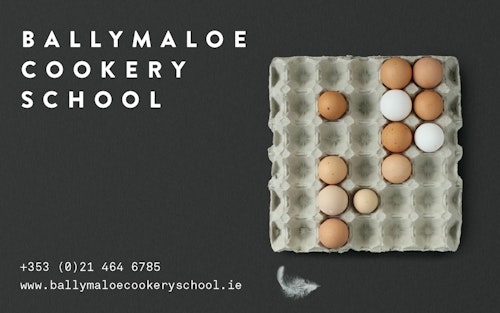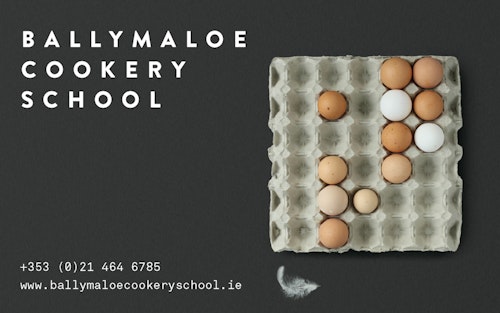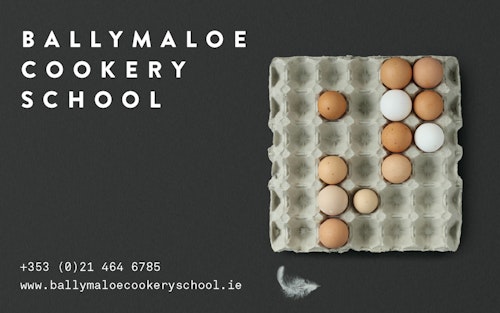- Ballymaloe Cheese Fondue
- Roast Rack of Spring Lamb with Haricot Beans with tomato and rosemary, and Rustic Roast Potatoes.
- Serves 2 Ask your butcher to prepare the rack of lamb for you. 1 rack of local Irish lamb (6 cutlets) salt and freshly ground pepper Accompaniment Mint Chutney, Haricot Beans with Tomato and Rosemary and Rustic Roast Potatoes Garnish Sprigs of mint Sprinkle the rack of lamb with salt and freshly ground pepper, place on a roasting tin. Roast fat side upwards for 25-30 minutes depending on the age of lamb and degree of doneness required. When cooked, remove lamb to a warm serving dish. Turn off the oven and allow the lamb to rest for 5-10 minutes before carving to allow the juices to re-distribute evenly through the meat. Carve the lamb and serve 2-3 cutlets per person depending on size. Serve with fresh Mint chutney, Haricot Beans with Tomato and Rosemary and Rustic Roast Potatoes. Haricot or Flageolet Beans with Tomato and Rosemary Serve as an accompaniment to the lamb or as a vegetarian dish. You can always use the extra to make a Gratin dish for another meal. Serves 4-6 1 cup dried haricot beans or flageolet beans or 2 x 14 oz (400g) cans of cooked beans Bouquet garni 1 onion 1 carrot 3 tablespoons olive oil 6 ozs (170g) chopped onion 4 large cloves garlic, crushed 1 x 14 oz (400g) tin tomatoes 1 large sprig rosemary chopped, approx 1 tablesp. Salt, freshly ground pepper and sugar Soak the beans overnight in plenty of cold water. Next day, strain the beans and cover with fresh cold water, add a bouquet garni, carrot and onion, cover and simmer until the beans are soft but not mushy - anything from 30-60 minutes. Just before the end of cooking, add salt. Remove the bouquet garni and vegetables and discard. Meanwhile sweat the chopped onion gently in olive oil in a wide saucepan until soft but not coloured, approx. 7-8 minutes add the garlic and cook for another minute or two, add the chopped tomato and their juice, add the cooked beans, and chopped rosemary. Simmer for 10-15 minutes add some of the bean liquid if necessary and season well with salt, freshly ground pepper and sugar. Note: The mixture should be juicy but not swimming in liquid. Gratin of Haricot Beans with Tomato and Rosemary Put the mixture in a shallow ovenproof dish. Scatter a mixture of buttered crumbs and grated cheese over the top and put into a hot oven or flash under a grill until crisp and golden on top. Rustic Roast Potatoes
- Fresh Mint Chutney
- Bananas and Passion Fruit in Lime Syrup
- A delicious fresh tasting fruity dessert that shouldn’t add inches to your waistlines.
- Chocolate Mousse
- 225g (½ lb) of best quality dark chocolate
- Chocolate Caraque
I've always been an incurable romantic, students tease me about the number of times I use a heart-shaped cutter to decorate pies and tarts. I make heart-shaped biscuits, pretty little heart-shaped Coeur a la crème, and scatter heart-shaped croutons over soup, a teency bit obsessive, not to mention unsubtle, but fun and great for a giggle. Well, with Valentine’s Day coming up we can legitimately indulge our romantic side and go seriously over the top. Let’s start at the beginning, get out the coloured pens and paper and make a heart-shaped invitation. Keep it light-hearted and fun – mustn’t pretend you are too serious, might scare him away even before you get him to the table. Yes, the invite is for dinner – remember the way to every chap’s heart and all that – its worth a try anyway! If you can’t quite manage a three course meal how about whipping up some little fairy cakes, ice them with bright pink and white icing and decorate them with those adorable little candles which spell out I LOVE YOU – in fact they would make a pretty edible centrepiece for your dinner table – set the scene with scented candles, dark red roses, love hearts in a glass bowl and pretty napkins. Champagne or bubbly of some kind is a must – drink it not just as an aperitif, but sip it all the way through to heighten the feeling of fun and excitement. So what to eat? Its difficult to choose – should it be comfort food or OTT luxury? Crunchy cruditees with a bowl of garlic mayonnaise would be delicious and fun, but perhaps the garlic might not be a good idea later. You may want to choose some aphrodisiac food - a couple of dozen oysters, some lobster, caviar, or wild mushrooms. If you are really trying to bring on a proposal though, beware of seeming too extravagant – he may conclude that you would be far too expensive to keep! So how about cheese fondue with lots of crusty white bread for dunking (in fact this could be served as a starter or a main dish.) A rack of lamb with a gutsy bean stew would make a delicious main course served with a few rustic roast potatoes. Looks impressive but it is very easy to cook and there will be lots of time for soulful chat while the meat and potatoes are roasting. For dessert there’s lots of sweet nonsense, pretty little heartshaped Coeur a la crème are adorable, serve with poached apricots. The dark intensity of chocolate mousse is perfect to linger over with a cup of freshly ground expresso, or you may want to finish on something fruity like this Banana and Passion Fruit in lime syrup. If you can’t cook – don’t despair - little notes with secret messages tucked into wallets beside credit cards, or behind the sun shade in the car, or even into a shoe, will give most people an oops in their tummy, or at least a giggle. Happy Valentine’s Day.
Ballymaloe Cheese Fondue
Myrtle Allen devised this Cheese Fondue recipe made from Irish Cheddar cheese. It's a great favourite at Ballymaloe and even though it's a meal in itself it may be made in minutes and is loved by adults and children alike. A fondue set is obviously an advantage but not essential.
Serves 2
2 tablesp. white wine
2 small cloves of garlic, crushed
2 teasp. Ballymaloe Tomato Relish or any tomato chutney
2 teasp. freshly chopped parsley
6 ozs (170g) grated mature Cheddar cheese
Crusty white bread
Put the white wine and the rest of the ingredients into a small saucepan or fondue pot and stir. Just before serving put over a low heat until the cheese melts and begins to bubble. Put the pot over the fondue stove and serve immediately with fresh French bread or cubes of ordinary white bread crisped up in a hot oven.
Roast Rack of Spring Lamb with Haricot Beans with tomato and rosemary, and Rustic Roast Potatoes.
Serves 2 Ask your butcher to prepare the rack of lamb for you. 1 rack of local Irish lamb (6 cutlets) salt and freshly ground pepper Accompaniment Mint Chutney, Haricot Beans with Tomato and Rosemary and Rustic Roast Potatoes Garnish Sprigs of mint Sprinkle the rack of lamb with salt and freshly ground pepper, place on a roasting tin. Roast fat side upwards for 25-30 minutes depending on the age of lamb and degree of doneness required. When cooked, remove lamb to a warm serving dish. Turn off the oven and allow the lamb to rest for 5-10 minutes before carving to allow the juices to re-distribute evenly through the meat. Carve the lamb and serve 2-3 cutlets per person depending on size. Serve with fresh Mint chutney, Haricot Beans with Tomato and Rosemary and Rustic Roast Potatoes. Haricot or Flageolet Beans with Tomato and Rosemary Serve as an accompaniment to the lamb or as a vegetarian dish. You can always use the extra to make a Gratin dish for another meal. Serves 4-6 1 cup dried haricot beans or flageolet beans or 2 x 14 oz (400g) cans of cooked beans Bouquet garni 1 onion 1 carrot 3 tablespoons olive oil 6 ozs (170g) chopped onion 4 large cloves garlic, crushed 1 x 14 oz (400g) tin tomatoes 1 large sprig rosemary chopped, approx 1 tablesp. Salt, freshly ground pepper and sugar Soak the beans overnight in plenty of cold water. Next day, strain the beans and cover with fresh cold water, add a bouquet garni, carrot and onion, cover and simmer until the beans are soft but not mushy - anything from 30-60 minutes. Just before the end of cooking, add salt. Remove the bouquet garni and vegetables and discard. Meanwhile sweat the chopped onion gently in olive oil in a wide saucepan until soft but not coloured, approx. 7-8 minutes add the garlic and cook for another minute or two, add the chopped tomato and their juice, add the cooked beans, and chopped rosemary. Simmer for 10-15 minutes add some of the bean liquid if necessary and season well with salt, freshly ground pepper and sugar. Note: The mixture should be juicy but not swimming in liquid. Gratin of Haricot Beans with Tomato and Rosemary Put the mixture in a shallow ovenproof dish. Scatter a mixture of buttered crumbs and grated cheese over the top and put into a hot oven or flash under a grill until crisp and golden on top.
Rustic Roast Potatoes
Serves 2-3
These are my children's favourite kind of roast spuds. They particularly love all the crusty skin. 3 large 'old' potatoes eg. Golden Wonder or Kerrs Pinks Olive oil or beef dripping (unless for Vegetarians)-duck or goose fat are also delicious Sea salt Preheat the oven to 230C/450F/regulo 8. Scrub the potatoes well, cut into quarters lengthways or cut into thick rounds ¾ inch (2cm) approx. Put into a roasting tin, drizzle with olive oil and toss so they are barely coated with olive oil. Roast in a preheated oven for 15-20 minutes depending on size. Sprinkle with sea salt and serve in a hot terracotta dish.
Fresh Mint Chutney
This fresh chutney is often served in India with curries. It can also be eaten with grilled fish or roast lamb instead of mint sauce. Surprisingly, even though it is uncooked, this chutney will keep for several days in a covered jar or plastic container in the refrigerator.
1 large cooking apple (we use Grenadier or Bramley Seedling), peeled and cored a large handful of fresh mint leaves, Spearmint of Bowles mint 55g (2oz) onions 30-55g (1-2oz) castor sugar (depending on tartness of apple) Whizz all the ingredients in a food processor, season with salt and a little cayenne pepper. Tip: Serve mint chutney as a really yummy dip with poppodums before dinner or as a simple starter.
Bananas and Passion Fruit in Lime Syrup
A delicious fresh tasting fruity dessert that shouldn’t add inches to your waistlines.
Serves 2 generously 4 ozs (110 g) sugar 4 fl ozs (125ml) water 1 lime 2 bananas 1 passion fruit Put the sugar and water into a saucepan, stir over a gentle heat until the sugar dissolves, bring to the boil and simmer for 2 minutes, allow to cool. Meanwhile, remove the zest from the lime either with a zester or a fine stainless steel grater and add to the syrup with the juice of the lime, add the sliced bananas mix well. over with cold syrup. Cut the passion fruit in half, scoop out the seeds and add to the bowl. Stir well. Leave to macerate for at least an hour. Serve chilled with heart-shaped biscuits and softly whipped cream. Jane's Biscuits - Shortbread Biscuits Makes 25 – you will have lots to share! 6 ozs (170g) white flour 4 ozs (110g) butter 2 ozs (55g) castor sugar Put the flour and sugar into a bowl, rub in the butter as for shortcrust pastry. Gather the mixture together and knead lightly. Roll out to ¼ inch (7mm) thick. Cut into rounds with a 2½ inch (6cm) cutter or heart shapes. Bake in a moderate oven 180C/350F/regulo 4 to pale brown, 8-15 minutes, depending on the thickness of the biscuits. Remove and cool on a rack. Serve with fruit fools, compotes and ice creams. Note: Watch these biscuits really carefully in the oven. Because of the high sugar content they burn easily. They should be a pale golden colour - darker will be more bitter. Chocolate Hearts filled with Silky Chocolate Mousse Serves 10 10 heart-shaped Chocolate Cases
Chocolate Mousse
225g (½ lb) of best quality dark chocolate
150ml (5 fl ozs) water 15g (½oz) unsalted butter 1 tablespoon Jamaica Rum 6 small or 4 large free range eggs
Chocolate Caraque
115g (4ozs) dark chocolate or a packet of chocolate decorations
Decoration Whipped cream Chocolate Caraque Unsweetened cocoa Make the mousse. Break chocolate into small pieces and put to melt in a bowl with the unsalted butter and water over a low heat. Stir gently until melted and completely smooth. Remove, cool, whisk in the rum if using and the egg yolks. Whisk the egg whites and fold them in. Beat for 5-6 minutes, this makes the mousse smooth and silky even though it sounds like a contradiction. The mousse thickens as it is beaten at the end. Fill each chocolate case with the mousse. Allow to set for 5 or 6 hours or overnight. Then make the Caraque. Melt the chocolate and spread it thinly with a palette knife onto a marble slab. Allow it to set almost completely and then with a sharp knife or a paint scraper shave off long, thin scrolls. Use a slightly sawing movement and keep your hand upright. This is fun to do but there’s quite a lot of skill involved - you’ll get good at it with practice and you can always eat the rejects! Alternatively buy a packet of those little chocolate decorations. To serve Pipe a rosette of softly whipped cream onto each mousse. Top with a few pieces of caraque. Sieve a little unsweetened cocoa over the top and serve chilled. Sprinkle with rose petals if you want to go over the top.




